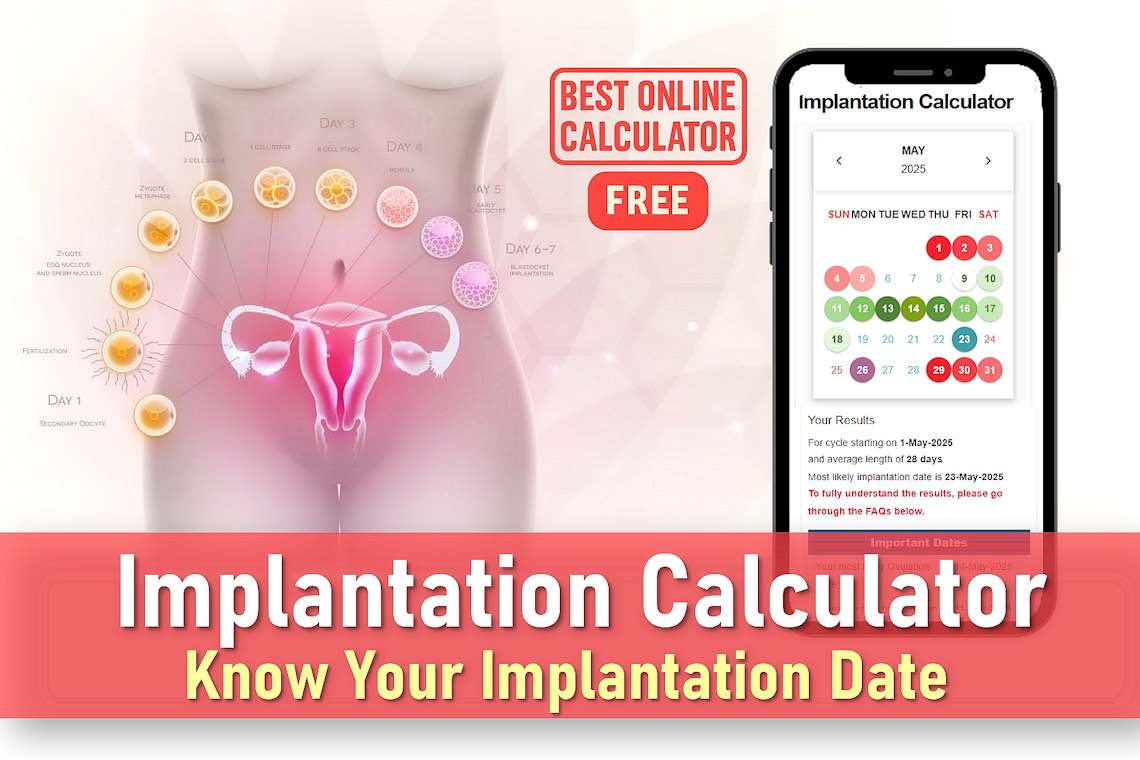Implantation Calculator: When Does Implantation Happen?
Wondering when implantation might occur? An implantation calculator can help you estimate this key milestone in early pregnancy. Implantation happens when a fertilized egg attaches to the uterine wall, typically 8 to 10 days after ovulation. By entering details like your ovulation date or menstrual cycle information, this tool provides insights into your early pregnancy timeline. Whether you’re actively trying to conceive or simply tracking your cycle, understanding implantation timing can offer valuable clues.
Select first day of your last period *
Related Calculators
How the Implantation Calculator Works and What Results You’ll See
This calculator allows you to choose one of two input options:
- Start date of your last period and average cycle length
- Exact ovulation date, if known
Based on your input, it provides a personalized and detailed report that includes:
- Ovulation Date: An estimate of your ovulation day along with a possible range
- Fertile Window: The days you’re most likely to conceive
- Implantation Window: The likely date range when embryo implantation may occur
- Pregnancy Testing: The earliest day a blood hCG test might show positive results
- Next Expected Period: Projected based on your cycle length
- Estimated Due Date: If pregnancy is confirmed, this is your projected delivery date
- Safe Delivery Window: The medically recognized time frame for full-term birth
Understanding the Implantation Timeline
Once ovulation occurs, the egg remains viable for approximately 12 to 24 hours. If fertilized, it travels down the fallopian tube toward the uterus. Implantation typically occurs between 6 and 12 days after ovulation, with the majority (about 84%) taking place between days 8 and 10, and day 9 being the most common. For example, if ovulation happens on day 14 of a 28-day cycle, implantation is most likely to occur between days 22 and 24.
Understanding Calculator Limitations
While many cycle trackers assume a standard 28-30 day cycle, every woman’s pattern differs. Your actual fertile window and ovulation date depend on how regular your cycles are and how closely you track them. Those with irregular periods should note that implantation calculators provide less precise estimates, as they rely on consistent cycle lengths and ovulation timing.
Interpreting Your Results
Your implantation calculator results serve two primary purposes:
- Pregnancy testing timing: Since implantation typically occurs 6-10 days after ovulation, knowing this window helps determine when to take a pregnancy test for accurate results.
- Due date estimation: These calculations help establish a potential due date, as by the time you receive a positive test, you’re likely 1-2 weeks pregnant.
Early in pregnancy, these estimates help gauge how far along you are and what to expect during initial development.
The Role of hCG During Implantation
After the embryo implants in the uterine wall, the developing placenta begins producing human chorionic gonadotropin (hCG), the pregnancy hormone. Within about ten days post-fertilization, early pregnancy symptoms may emerge as hCG levels rise.
Initially, hCG concentrations may be too low for home pregnancy tests to detect. However, levels typically double every 48-72 hours in early pregnancy. Using your implantation calculator results helps time testing for better accuracy, as testing too early might yield false negatives despite actual pregnancy.
While hCG patterns vary between women, most will show detectable levels within the first few weeks, often accompanied by symptoms like nausea, fatigue, and breast tenderness.
When to Take a Pregnancy Test After Implantation
Most home pregnancy tests can detect hCG at concentrations of 20-50 mIU/ml. Testing too early, before sufficient hCG accumulates, may produce false negatives. Consider these testing timelines:
- First day of missed period: Tests are about 90% accurate
- One week after missed period: Accuracy increases to 97%
An implantation calculator helps identify the optimal testing window—typically about a week after suspected implantation—for the most reliable results. This method proves more accurate than estimating based solely on period dates or implantation symptoms alone.
Recognizing Signs of Successful Implantation
While only a positive pregnancy test can definitively confirm successful implantation, some women notice early indicators that may suggest pregnancy before testing. These potential signs include:
- Implantation bleeding: About 15-25% of pregnant women experience light pink or brown spotting around the time of implantation, typically lighter and shorter than a regular period.
- Mild cramping: Some women report slight abdominal discomfort that may radiate to the lower back or thighs during implantation.
- Fatigue: Nearly all pregnant women experience increased tiredness in early pregnancy as the body works harder to support the developing embryo.
- Breast tenderness: Hormonal changes, particularly rising hCG and progesterone levels, often cause breast sensitivity early in pregnancy.
While these symptoms may hint at pregnancy, they’re not definitive proof. If you experience persistent symptoms but receive negative test results, consult your healthcare provider for further evaluation.
Advantages of Using an Implantation Calculator
An implantation calculator offers several benefits for those tracking potential pregnancy:
- Optimizes testing timing: Helps determine the best window for pregnancy testing, reducing the likelihood of false negatives.
- Assists with irregular cycles: Provides guidance even when periods are inconsistent, helping identify when testing might be most effective.
- Establishes pregnancy timeline: Creates a clearer picture of conception and implantation dates, which aids in estimating due dates.
- Supports IVF tracking: For those undergoing fertility treatments, the calculator can use embryo transfer dates to predict implantation timing.
Common Questions About Implantation Calculators
Can women with PCOS use implantation calculators effectively?
While possible, results may be less reliable for women with PCOS due to irregular ovulation patterns. PCOS symptoms can sometimes mimic early pregnancy signs, making interpretation challenging. Always confirm calculator results with your doctor, especially if you receive positive pregnancy test results.
Can these calculators predict pregnancy likelihood?
Implantation calculators don’t assess conception probability, they only estimate when implantation might have occurred if fertilization took place. Their primary purpose is helping determine the optimal time for pregnancy testing based on your cycle data.
When Does Implantation Bleeding Occur?
Implantation bleeding typically happens around 10 to 14 days after ovulation, usually a few days before a missed period. Because of its timing, many people mistake it for an early or light period. If you experience light spotting before your expected period, it might be implantation bleeding rather than menstruation










